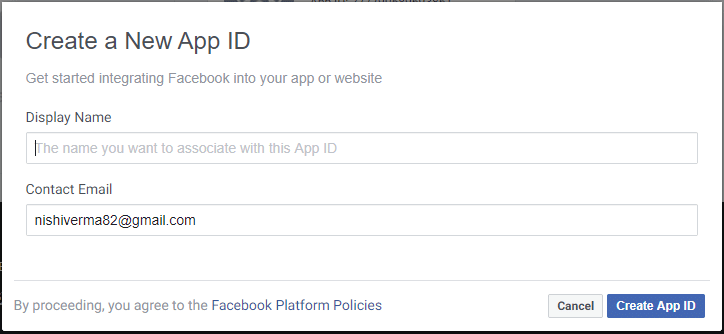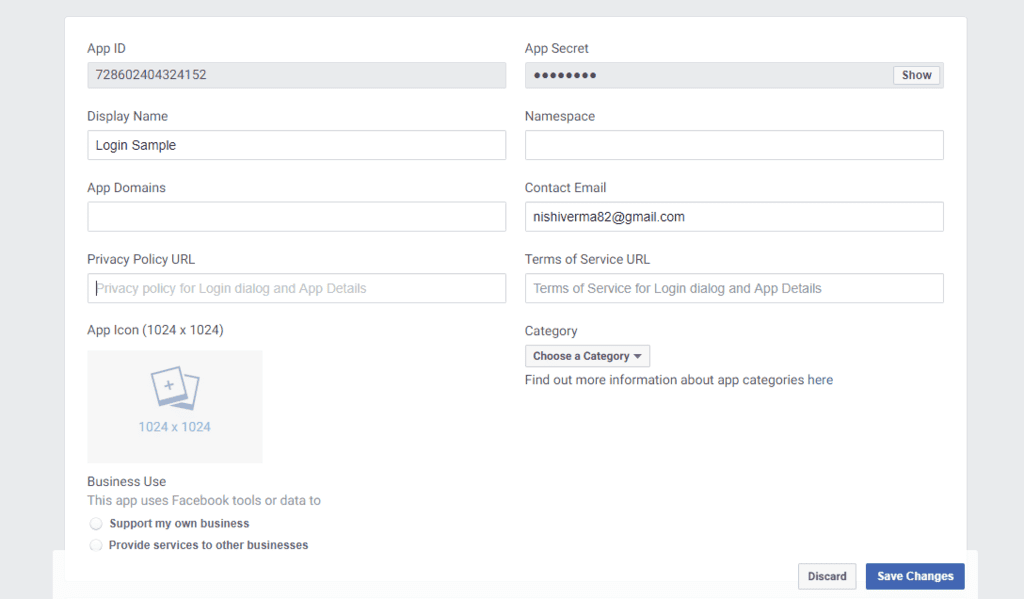How to create a Facebook login using an Android App? - Software Development PDF Download
How to create a Facebook login using an Android App?
Last Updated: 23 Feb, 2021In this guide, we will discuss the process of integrating a Facebook login into an Android application. Social logins are a common feature in mobile apps, and Facebook login integration is a popular choice. To enable Facebook login functionality, we need to incorporate the Facebook SDK into our project.
Social Login using Facebook
Here are the steps to implement Facebook login in your Android app:
- Step 1: Obtain a Facebook Developer Account and create a new app.
- Step 2: Install Android Studio (version 3.0 or higher) and open/create a project where you wish to incorporate Facebook login.
- Step 3: Add the following code snippet in your project's Gradle Scripts -> build.gradle (Project):
buildscript{ repositories { jcenter() } } - Step 4: Include the following code in Gradle Scripts -> build.gradle (Module:app) using the latest version of Facebook Login SDK in your project:
dependencies { implementation 'com.facebook.android:facebook-android-sdk:5.0.0' } - Step 5: Sync your project.
- Step 6: Navigate to app -> res -> values -> strings.xml file and insert the following lines, replacing [APP_ID] with your actual APP_ID obtained from the Facebook Developer console:
[APP_ID] fb[APP_ID]

By following these steps, you can successfully integrate Facebook login into your Android app.
Facebook Integration for Android Application
Facebook integration in an Android application involves several key steps to enable seamless interaction with the Facebook platform. Below are the essential points to consider:
- Setting up Facebook SDK
- Begin by adding the Facebook App ID and login protocol scheme to your AndroidManifest.xml file.
- Example: Open the AndroidManifest.xml file and include the following line outside the application element:
<uses-permission android:name="android.permission.INTERNET"/>
- Adding Meta-Data
- Insert the meta-data element inside the application element in the AndroidManifest.xml file.
- Example: Add the following meta-data inside your application element:
<meta-data android:name="com.facebook.sdk.ApplicationId" android:value="@string/facebook_app_id"/>
- Obtaining Key Hash
- To generate the Key Hash, implement the necessary code in your activity class before the Facebook login code.
- Example: Include the code to print out the key hash in your activity class as shown in the provided snippet.
Manifest File Configuration
The AndroidManifest.xml file plays a crucial role in defining various aspects of your Android application, including permissions and metadata.
 |
Android Facebook Login Integration
- Now, execute your application on either the emulator or a connected device. Subsequently, check the logcat to view the Key Hash value displayed. It is crucial to save this value for future reference.
- Access the Facebook Developers console and navigate to Settings -> Basic -> Add Platform (located at the bottom of the page). A popup window will emerge, prompting you to select a platform. Opt for Android as the platform of choice.
Configuring Facebook Developer Settings
- Integrate your project's package name under 'Google Play Package Name.' Additionally, include the class name where the login functionality will be implemented in the project (e.g., 'LoginActivity'). Also, ensure to input the key hash value under 'Key Hashes.'
| Facebook Developers console | setting -> Basic -> Add Platform | select a platform | Android |
|---|---|---|---|
| Add your project package name under 'Google Play Package Name'. Add class name where login will implement in project like 'LoginActivity' and also add the key hash value under 'Key Hashes'. |
Adding Custom Facebook Login Button in Android Studio
- Start by integrating a customized Facebook login button into your Android app.
- In your Android Studio project, modify the *.xml layout file:
- Add the following code snippet to include the custom button:
- *.xml
- Define the button style in the styles.xml file within the app directory:
- Add the following code within app -> res -> styles.xml:
Creating a Facebook Login Button for Android App
- You have the option to customize the Facebook Login Button according to your preferences. Alternatively, you can utilize the default Facebook button, known as Facebook LoginButton.
- For customization, create a drawable file named 'bg_button_facebook.xml' in the 'app -> res -> drawable' directory. Insert the following XML code into the file:
Initializing the Facebook Login Button
- In your *.java file, initialize the button and include the necessary code to set up the Facebook SDK:
// Declare variablesprivate Button mButtonFacebook;private CallbackManager callbackManager;private LoginManager loginManager;@Overrideprotected void onCreate(Bundle savedInstanceState) { super.onCreate(savedInstanceState); setContentView(R.layout.activity_login); // Initialize Facebook button mButtonFacebook = findViewById(R.id.button_facebook); FacebookSdk.sdkInitialize(MainActivity.this); callbackManager = CallbackManager.Factory.create(); facebookLogin(); // Set OnClickListener for the Facebook button mButtonFacebook.setOnClickListener(new View.OnClickListener() { @Override public void onClick(View v) { loginManager.logInWithReadPermissions(MainActivity.this, Arrays.asList("email", "public_profile", "user_birthday")); } });}
Make sure to include the necessary imports and permissions in your AndroidManifest.xml file for the Facebook login functionality to work correctly.
Variables and Initialization
- Declare variables:
private Button mButtonFacebook;,CallbackManager callbackManager;,LoginManager loginManager; - Initialize variables:
mButtonFacebook = findViewById(R.id.button_facebook);,FacebookSdk.sdkInitialize(MainActivity.this);,callbackManager = CallbackManager.Factory.create();
Creating Facebook Login Functionality
- Add the
facebookLoginmethod outsideonCreate()in the Java file to handle Facebook login responses.
Facebook Login Method
- facebookLogin: This method manages the Facebook login process and response.
- Example: In the
facebookLoginmethod,onSuccesshandles successful login, retrieving user information like name, email, and user ID. - Example: Error handling is done in the
onErrormethod, where actions in case of errors are specified.
Handling Facebook Login Responses
- Within
facebookLogin,onSuccessprocesses the successful login result by extracting user data using Graph API. - Example: The
GraphRequestinonSuccessfetches specific user details such as name, email, and birthday from the Facebook Graph. onErroris triggered in case of login errors and defines error-handling procedures.
Facebook Integration in Android Application
- facebookLogin()
To enable Facebook login in your Android application, you need to implement the
facebookLogin()method. This method initializes the necessary components for Facebook login, such as theLoginManagerandCallbackManager, and handles the login process. - disconnectFromFacebook()
This method is essential for disconnecting the application from Facebook once the user is done with the login process. It ensures that the user is logged out from Facebook and revokes necessary permissions.
Implementing Facebook Login
The
facebookLogin()method sets up Facebook login by initializing theLoginManagerandCallbackManager.Upon successful login, user data like name, email, and user ID is retrieved using a
GraphRequest.Error handling is crucial in case of login failures to ensure a smooth user experience.
Disconnecting from Facebook
The
disconnectFromFacebook()method is used to disconnect the application from Facebook, logging the user out and revoking permissions.This method ensures that the user's session is terminated correctly to maintain data privacy and security.
Sample Code Explanation
Public method It checks for an active access token and performs necessary actions to ensure proper disconnection. |
Disconnecting from Facebook
- Utilize the
disconnectFromFacebook()method to log out from Facebook. - Check if the user is already logged out before executing the log out process.
- Ensure successful disconnection by revoking permissions using Graph API.
Implementing onActivityResult Method
- Add the
onActivityResultmethod outsideonCreatein the same activity. - Include the necessary callback to handle the result of an activity started for a result.
- Make sure to call
callbackManager.onActivityResult()to properly handle the result.
Running Your Application and Logging in with Facebook
- After completing the coding, run your application on a device or emulator.
- Verify that you can now log in using Facebook within your application.
Enabling App Status for Play Store
- To publish your app on the Play Store, activate the 'status' feature on Facebook for Developers.
- Add a privacy policy URL in the settings under 'Basic' as indicated in the provided instructions.
- Save the changes and enable the status from the dashboard to proceed with publishing your app.

Please Login to comment...
LoginLikeParaphrased Information
- Heading 1 (Bold): Explanation of heading 1.
- Example 1 illustrating heading 1.
- Example 2 providing further insight.
- Heading 2 (Bold): Elaboration on the second main point.
- Example for the second main point.
- Another example to clarify.
- Heading 3: Detailing the third important aspect.
- Example related to the third aspect.
- Additional example to enhance understanding.
- Heading 4: Explaining the fourth crucial point.
- Illustrative example for the fourth point.
- Another example to solidify the concept.
- Heading 1 (Bold): Explanation of heading 1.



















